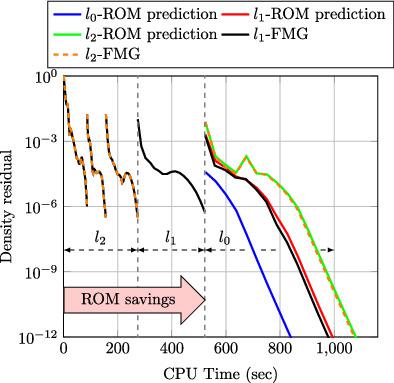当前位置:
X-MOL 学术
›
Int. J. Numer. Methods Fluids
›
论文详情
Our official English website, www.x-mol.net, welcomes your
feedback! (Note: you will need to create a separate account there.)
Accelerating CFD solver computation time with reduced‐order modeling in a multigrid environment
International Journal for Numerical Methods in Fluids ( IF 1.7 ) Pub Date : 2020-07-12 , DOI: 10.1002/fld.4892 Niklas Karcher 1 , Marcel Wallraff 1
International Journal for Numerical Methods in Fluids ( IF 1.7 ) Pub Date : 2020-07-12 , DOI: 10.1002/fld.4892 Niklas Karcher 1 , Marcel Wallraff 1
Affiliation

|
Reduced‐order models (ROMs) are more and more considered for use in aerodynamic applications. Benefits of these methods can be expected for optimization problems or predicting aerodynamic loads for the entire flight envelope. For these applications it is often possible to perform computations for various parameter combinations before any ROM evaluations are needed. The order reduction of the CFD solutions in this article is done using proper orthogonal decomposition. Coupled with an interpolation method predictions for unknown parameter combinations can be made. The CFD solutions are computed using a discontinuous Galerkin finite element method combined with a nonlinear multigrid scheme. The nonlinear multigrid solver algorithms depend on a good initial guess of the flow field to be computed. Typically, the initial guess on a fine mesh is obtained by solving the problem on a agglomerated mesh. Alternatively, an initial guess could be obtained from a ROM prediction, if available. The main objective is to identify the benefits of using a ROM in a higher‐order multigrid environment. Integral as well as distributed surface quantities of the ROM predictions originating from several multigrid levels will be compared with fully converged flow solutions on the top level of the multigrid algorithm. Furthermore, initializing the flow solver with predictions from several multigrid levels will be analyzed in comparison to full multigrid computations as well as to a scenario where already converged solutions for similar parameter combinations are used as initial flow solutions on the top multigrid level.
中文翻译:

在多网格环境中使用降阶建模加快CFD求解器的计算时间
降阶模型(ROM)越来越多地考虑用于空气动力学应用中。对于优化问题或预测整个飞行包线的空气动力负荷,可以预期使用这些方法的好处。对于这些应用,通常有可能在需要任何ROM评估之前执行各种参数组合的计算。本文中CFD解决方案的降阶是使用适当的正交分解完成的。结合插值方法,可以对未知参数组合进行预测。使用不连续的Galerkin有限元方法与非线性多重网格方案相结合来计算CFD解决方案。非线性多重网格求解器算法取决于要计算的流场的良好初始猜测。通常,通过解决凝聚网格上的问题,可以得出关于精细网格的初步猜测。或者,可以从ROM预测中获得初始猜测(如果有)。主要目的是确定在更高阶的多网格环境中使用ROM的好处。ROM预测的积分以及分布的表面数量(来自多个多重网格级别)将与多重网格算法顶层的完全收敛的流量解决方案进行比较。此外,与完全多网格计算以及将类似参数组合的已收敛解决方案用作顶级多网格级别的初始流解决方案的情况相比,将分析使用多个多网格级别的预测来初始化流求解器。或者,可以从ROM预测中获得初始猜测(如果有)。主要目的是确定在更高阶的多网格环境中使用ROM的好处。ROM预测的积分以及分布的表面数量(来自多个多重网格级别)将与多重网格算法顶层的完全收敛的流量解决方案进行比较。此外,与完全多网格计算以及将类似参数组合的已收敛解决方案用作顶级多网格级别的初始流解决方案的方案相比,将分析使用多个多网格级别的预测来初始化流求解器。或者,可以从ROM预测中获得初始猜测(如果有)。主要目的是确定在更高阶的多网格环境中使用ROM的好处。ROM预测的积分以及分布的表面数量(来自多个多重网格级别)将与多重网格算法顶层的完全收敛的流量解决方案进行比较。此外,与完全多网格计算以及将类似参数组合的已收敛解决方案用作顶级多网格级别的初始流解决方案的方案相比,将分析使用多个多网格级别的预测来初始化流求解器。主要目的是确定在更高阶的多网格环境中使用ROM的好处。ROM预测的积分以及分布的表面数量(来自多个多重网格级别)将与多重网格算法顶层的完全收敛的流量解决方案进行比较。此外,与完全多网格计算以及将类似参数组合的已收敛解决方案用作顶级多网格级别的初始流解决方案的方案相比,将分析使用多个多网格级别的预测来初始化流求解器。主要目的是确定在更高阶的多网格环境中使用ROM的好处。ROM预测的积分以及分布的表面数量(来自多个多重网格级别)将与多重网格算法顶层的完全收敛的流量解决方案进行比较。此外,与完全多网格计算以及将类似参数组合的已收敛解决方案用作顶级多网格级别的初始流解决方案的方案相比,将分析使用多个多网格级别的预测来初始化流求解器。ROM预测的积分以及分布的表面数量(来自多个多重网格级别)将与多重网格算法顶层的完全收敛的流量解决方案进行比较。此外,与完全多网格计算以及将类似参数组合的已收敛解决方案用作顶级多网格级别的初始流解决方案的方案相比,将分析使用多个多网格级别的预测来初始化流求解器。ROM预测的积分以及分布的表面数量(来自多个多重网格级别)将与多重网格算法顶层的完全收敛的流量解决方案进行比较。此外,与完全多网格计算以及将类似参数组合的已收敛解决方案用作顶级多网格级别的初始流解决方案的方案相比,将分析使用多个多网格级别的预测来初始化流求解器。
更新日期:2020-07-12
中文翻译:

在多网格环境中使用降阶建模加快CFD求解器的计算时间
降阶模型(ROM)越来越多地考虑用于空气动力学应用中。对于优化问题或预测整个飞行包线的空气动力负荷,可以预期使用这些方法的好处。对于这些应用,通常有可能在需要任何ROM评估之前执行各种参数组合的计算。本文中CFD解决方案的降阶是使用适当的正交分解完成的。结合插值方法,可以对未知参数组合进行预测。使用不连续的Galerkin有限元方法与非线性多重网格方案相结合来计算CFD解决方案。非线性多重网格求解器算法取决于要计算的流场的良好初始猜测。通常,通过解决凝聚网格上的问题,可以得出关于精细网格的初步猜测。或者,可以从ROM预测中获得初始猜测(如果有)。主要目的是确定在更高阶的多网格环境中使用ROM的好处。ROM预测的积分以及分布的表面数量(来自多个多重网格级别)将与多重网格算法顶层的完全收敛的流量解决方案进行比较。此外,与完全多网格计算以及将类似参数组合的已收敛解决方案用作顶级多网格级别的初始流解决方案的情况相比,将分析使用多个多网格级别的预测来初始化流求解器。或者,可以从ROM预测中获得初始猜测(如果有)。主要目的是确定在更高阶的多网格环境中使用ROM的好处。ROM预测的积分以及分布的表面数量(来自多个多重网格级别)将与多重网格算法顶层的完全收敛的流量解决方案进行比较。此外,与完全多网格计算以及将类似参数组合的已收敛解决方案用作顶级多网格级别的初始流解决方案的方案相比,将分析使用多个多网格级别的预测来初始化流求解器。或者,可以从ROM预测中获得初始猜测(如果有)。主要目的是确定在更高阶的多网格环境中使用ROM的好处。ROM预测的积分以及分布的表面数量(来自多个多重网格级别)将与多重网格算法顶层的完全收敛的流量解决方案进行比较。此外,与完全多网格计算以及将类似参数组合的已收敛解决方案用作顶级多网格级别的初始流解决方案的方案相比,将分析使用多个多网格级别的预测来初始化流求解器。主要目的是确定在更高阶的多网格环境中使用ROM的好处。ROM预测的积分以及分布的表面数量(来自多个多重网格级别)将与多重网格算法顶层的完全收敛的流量解决方案进行比较。此外,与完全多网格计算以及将类似参数组合的已收敛解决方案用作顶级多网格级别的初始流解决方案的方案相比,将分析使用多个多网格级别的预测来初始化流求解器。主要目的是确定在更高阶的多网格环境中使用ROM的好处。ROM预测的积分以及分布的表面数量(来自多个多重网格级别)将与多重网格算法顶层的完全收敛的流量解决方案进行比较。此外,与完全多网格计算以及将类似参数组合的已收敛解决方案用作顶级多网格级别的初始流解决方案的方案相比,将分析使用多个多网格级别的预测来初始化流求解器。ROM预测的积分以及分布的表面数量(来自多个多重网格级别)将与多重网格算法顶层的完全收敛的流量解决方案进行比较。此外,与完全多网格计算以及将类似参数组合的已收敛解决方案用作顶级多网格级别的初始流解决方案的方案相比,将分析使用多个多网格级别的预测来初始化流求解器。ROM预测的积分以及分布的表面数量(来自多个多重网格级别)将与多重网格算法顶层的完全收敛的流量解决方案进行比较。此外,与完全多网格计算以及将类似参数组合的已收敛解决方案用作顶级多网格级别的初始流解决方案的方案相比,将分析使用多个多网格级别的预测来初始化流求解器。









































 京公网安备 11010802027423号
京公网安备 11010802027423号